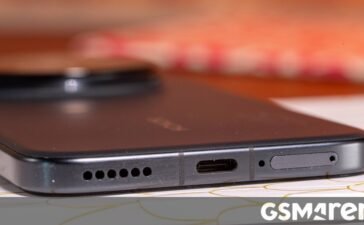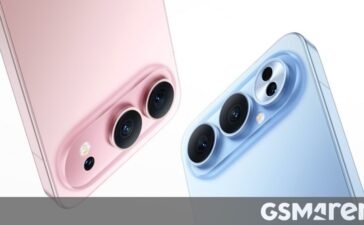It has been a pretty quiet week in the US market as far as smartphones are concerned, but Apple did unveil the M5 chipset and launched three new products with it. But let’s start with phones and with no new launches, we turn to the usual suspects.
The Samsung Galaxy S26 Edge has reportedly been canceled, to be replaced with the Galaxy S26+ – a phone that was once rumored to have been canceled itself. So, the Galaxy S25 Edge may remain Samsung’s thinnest phone for a while. It’s not as capable as its S25+ sibling, but at least it’s a lot cheaper.
Here’s the Samsung Galaxy S25+ for reference. You can check out our head-to-head article for an in-depth look at how the S25+ and S25 Edge compare.
The Nothing Phone (3) is another experiment with a questionable outcome – Nothing is trying to break into the flagship market. It certainly has its strengths, but it’s not up to competing with the top models from other makers. It is cheaper than those phones, though, so things like the LTPS display and average battery life don’t hurt as much. And it still has a versatile triple 50MP camera, a mostly clean UI, good speakers and the 6.67” 120Hz OLED display is pretty bright.
You can accessorize it with the Nothing Headphone (1), which has the same white and transparent look (though black and transparent is an option too). These are fairly heavy, but offer excellent sound quality and active noise cancellation. The build quality is great too.
Alternatively, the CMF Headphone Pro are much more “normal” looking and are a lot cheaper – even with the discount on the Headphone (1), these are less than half the price. We are working on a review for the CMF headphones, but the first impressions are great.
The Motorola Razr 2025 has been at $600 for a while now and this week is no different. This discount is no longer good enough.
The Motorola Razr+ 2025 uses some older hardware (it’s a re-release of the Razr Ultra 2024 but with an improved IP rating), but now it has a hefty discount that puts it at the same $600 price point as the vanilla Razr 2025. With the Plus model you get a Snapdragon 8s Gen 3 and faster UFS 4.0 storage (vs. Dimensity 7400X and UFS 2.2) plus a 50MP 2x telephoto camera (vs. 13MP 120° ultra-wide). The battery is smaller (4,000mAh vs. 4,500mAh) but has a slight lead in charging (45W wired vs. 30W, wireless charging is 15W on both phones).
There’s always the new Ultra, which has settled at the $1,000 mark. The Motorola Razr Ultra 2025 beats its predecessor (and thus the Plus) with a Snapdragon 8 Elite and a larger 50MP sensor in the main camera (1/1.56” vs. 1/1.95”). It also has a bigger, faster battery – 4,700mAh with 68W wired and 30W wireless charging.
Of course, the Ultra competes with the Samsung Galaxy Z Flip7, which has a small price advantage. Note that this year the US model uses the same Exynos 2500 as the models for the rest of the world. The 50MP main camera has a similarly-sized 1/1.57” sensor and it is joined by a 12MP ultra-wide module. The 4,300mAh battery is slow to charge at 25W over a wire and at 15W wirelessly.
You could save some money by going with the Samsung Galaxy Z Flip7 FE. This is another re-release of a 2024 model, though Samsung changed the chipset – gone is the Snapdragon 8 Gen 3 of the Z Flip6, replaced by an Exynos 2400. You can read more about how the Z Flip7 FE compares with the Z Flip7 for a closer look at what you are giving up to save $124 by picking the FE model.
The Samsung Galaxy Z Fold7 has a solid $400 discount, which places it $200 below its rival, the newly-launched Google Pixel 10 Pro Fold. We haven’t reviewed the Pixel yet, but we’ve done the rest of the Pixel 10 series and we can already tell you that the Tensor G5 is no match for the Snapdragon 8 Elite (yes, the Z Fold7 uses the Qualcomm chip, unlike the Z Flip7). The Pixel foldable is also thicker (10.8mm vs. 8.9mm) and heavier (258g vs. 215g), though it does have a larger battery (5,015mAh vs. 4,400mAh).
As we mentioned in the opening paragraph, Apple introduced the M5 chipset and it upgraded the iPad Pro 11” and 13” models with it. They also use other Apple chips – the N1 and C1X – so they have Wi-Fi 7 connectivity. Additionally, the USB-C port now features Adaptive Sync (variable refresh rate) up to 120Hz when hooked up to a compatible display (check your TV, a lot of OLEDs support this).
Apple also revamped the MacBook Pro with a new 14” model. However, this one uses Broadcom chips for wireless connectivity, so it only has Wi-Fi 6E. New chipset aside, the new Apple MacBook Pro 14” is largely the same as its M4 predecessor.
We may get a commission from qualifying sales.




















